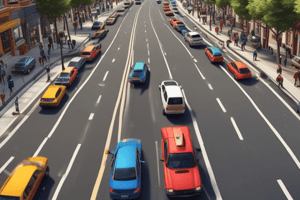Podcast
Questions and Answers
What should pedestrians do if there is no pavement?
What should pedestrians do if there is no pavement?
- Walk in the middle of the road
- Cross the road quickly
- Walk on the left side of the road
- Keep to the far right, facing oncoming traffic (correct)
What should cyclists do to prevent accidents?
What should cyclists do to prevent accidents?
- Wear dark clothing
- Use hand signals (correct)
- Cycle close to parked cars
- Ride side by side with other cyclists
Why is it important to wear a seat belt as a passenger?
Why is it important to wear a seat belt as a passenger?
- To make the driver feel safe
- To prevent injury in case of a collision (correct)
- To comply with the law
- To avoid fines
How can germs spread between people?
How can germs spread between people?
Flashcards
Walking on roads without sidewalks
Walking on roads without sidewalks
When walking on roads without sidewalks, stay close to the edge of the road on the right side, facing oncoming traffic.
Using hand signals while cycling
Using hand signals while cycling
Using hand signals helps other road users such as drivers and other cyclists understand your intentions.
Wearing a seatbelt as a passenger
Wearing a seatbelt as a passenger
Wearing a seatbelt helps protect passengers from serious injuries in case of a car accident.
Germs spreading
Germs spreading
Signup and view all the flashcards
Study Notes
Road Safety
- When there is no pavement, pedestrians should walk on the right side of the road, facing oncoming traffic, and try to stay away from the road edge.
- Pedestrians should also take extra care when walking on roads with no pavement, especially at night or in bad weather.
Cycling Safety
- Cyclists can prevent accidents by wearing helmets and following traffic rules, such as obeying traffic lights and stop signs.
- Cyclists should also make themselves visible by wearing bright clothes and using front and rear lights at night.
Vehicle Safety
- Wearing a seat belt as a passenger is crucial because it can reduce the risk of fatal injury by up to 50%.
- Seat belts help to keep passengers in their seats and prevent them from being thrown from the vehicle in the event of a crash.
Infection Prevention
- Germs can spread between people through direct contact, such as touching or shaking hands, and indirect contact, such as touching contaminated surfaces.
- Germs can also spread through the air when an infected person talks, coughs, or sneezes, releasing droplets that contain the germs.
Studying That Suits You
Use AI to generate personalized quizzes and flashcards to suit your learning preferences.




